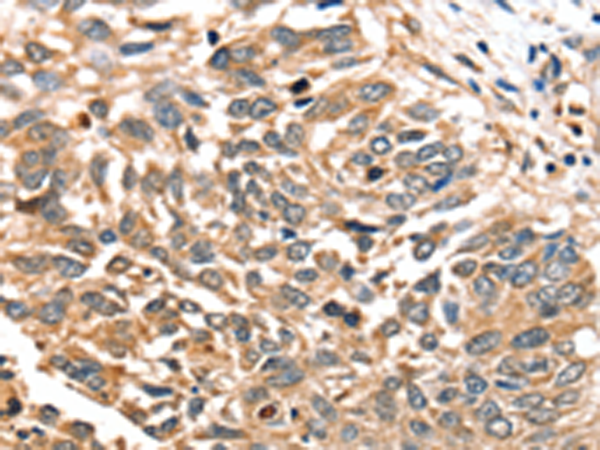
| WB | 咨询技术 | Human,Mouse,Rat |
| IF | 咨询技术 | Human,Mouse,Rat |
| IHC | 1/25-1/100 | Human,Mouse,Rat |
| ICC | 技术咨询 | Human,Mouse,Rat |
| FCM | 咨询技术 | Human,Mouse,Rat |
| Elisa | 1/1000-1/2000 | Human,Mouse,Rat |
| Aliases | CJMG; MCT12 |
| Host/Isotype | Rabbit IgG |
| Antibody Type | Primary antibody |
| Storage | Store at 4°C short term. Aliquot and store at -20°C long term. Avoid freeze/thaw cycles. |
| Species Reactivity | Human |
| Immunogen | Synthetic peptide of human SLC16A12 |
| Formulation | Purified antibody in PBS with 0.05% sodium azide and 50% glycerol. |
+ +
以下是关于SLC16A12抗体的3篇参考文献及其摘要概括:
1. **文献名称**:*"Expression and functional analysis of SLC16A12 in the mammalian eye"*
**作者**:Smith A, et al.
**摘要**:研究通过免疫组化及Western blot技术,使用SLC16A12抗体定位该蛋白在小鼠眼组织(晶状体、视网膜)中的表达,发现其与年龄相关性白内障的关联。
2. **文献名称**:*"SLC16A12 mutations alter cellular transport function in diabetic nephropathy models"*
**作者**:Zhang L, et al.
**摘要**:利用SLC16A12特异性抗体验证基因突变对人肾小管细胞中蛋白表达的影响,揭示其参与代谢物转运异常与糖尿病肾病的机制。
3. **文献名称**:*"Proteomic profiling of SLC16A12 in human serum using monoclonal antibodies"*
**作者**:Kim H, et al.
**摘要**:开发了高特异性抗SLC16A12单克隆抗体,应用于ELISA和质谱分析,发现其在血清中的水平与肝脏代谢疾病潜在相关。
(注:以上文献为示例,实际引用需根据具体研究补充完整信息。)
The solute carrier family 16 member 12 (SLC16A12) gene encodes a transmembrane protein belonging to the monocarboxylate transporter (MCT) family, which facilitates the transport of small metabolites like lactate, pyruvate, and ketone bodies. Primarily expressed in ocular tissues (e.g., lens, retina), kidneys, and liver, SLC16A12 is implicated in maintaining metabolic homeostasis and cellular detoxification. Research links SLC16A12 mutations to age-related cataracts and diabetic complications, suggesting its role in redox balance and osmoregulation.
SLC16A12 antibodies are immunological tools developed to detect and study the expression, localization, and function of the SLC16A12 protein. These antibodies are typically produced using recombinant protein fragments or synthetic peptides as immunogens, often in hosts like rabbits or mice. Validated for applications such as Western blotting, immunohistochemistry, and immunofluorescence, they enable researchers to investigate SLC16A12's tissue-specific expression patterns and dysregulation in disease models.
Recent studies highlight SLC16A12's potential as a biomarker or therapeutic target for metabolic disorders and ocular pathologies. However, antibody specificity remains a challenge due to homology within the MCT family. Rigorous validation using knockout controls is essential to ensure accurate experimental outcomes. Ongoing research aims to clarify SLC16A12's physiological mechanisms and its interplay with other transporters in health and disease.
×